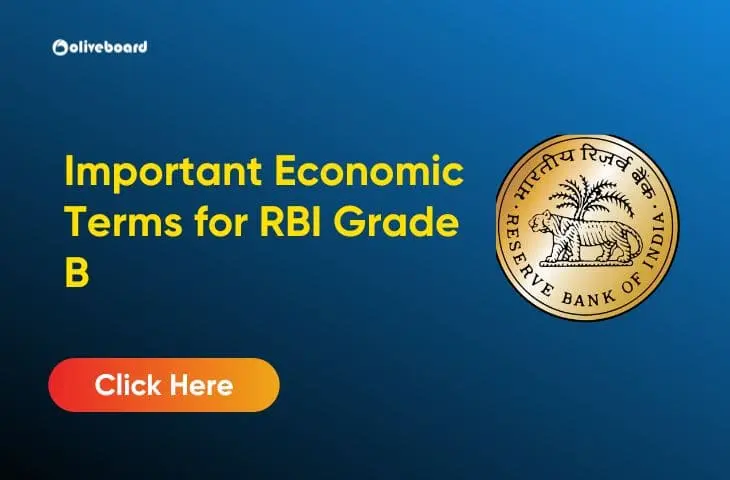Economic Terms for RBI Grade B Exam
Preparing for the RBI Grade B exam requires a solid understanding of various important economic terms and concepts. These terms form the foundation of economic theory and policy-making, which are key areas in the RBI Grade B syllabus. This blog will help you grasp some of these important terms in simple language, making your preparation smoother and more effective.
Important Economic Terms
Clearing the concepts is extremely important for any competitive exam. The candidates must know the definition of the economic term and why it matters. So, we have explained a few important economic terms below:
1. Gross Domestic Product (GDP)
- Definition: GDP is the total monetary value of all finished goods and services produced within a country’s borders in a specific time period, usually a year or a quarter.
- Why It Matters: GDP is a primary indicator used to measure the health of a country’s economy. A growing GDP usually signals a growing economy, while a shrinking GDP may indicate economic trouble.
2. Inflation
- Definition: Inflation refers to the rate at which the general level of prices for goods and services rises, eroding purchasing power.
- Why It Matters: Central banks, like the RBI, monitor inflation to ensure it remains within a target range. High inflation can reduce the value of money, whereas deflation (falling prices) can lead to reduced consumer spending and economic stagnation.
3. Monetary Policy
- Definition: Monetary policy is the process by which a central bank, such as the Reserve Bank of India (RBI), controls the supply of money, often targeting an inflation rate or interest rate to ensure price stability and general trust in the currency.
- Why It Matters: The RBI uses tools like the repo rate and reverse repo rate to manage money supply and influence inflation. Understanding monetary policy is essential for the RBI Grade B exam as it forms the core of the central bank’s functions.
4. Fiscal Policy
- Definition: Fiscal policy refers to the use of government spending and tax policies to influence economic conditions, including demand for goods and services, employment, inflation, and economic growth.
- Why It Matters: Fiscal policy impacts the economy by altering the levels of government expenditure and taxation. For instance, during a recession, a government might lower taxes and increase spending to stimulate the economy.
5. Repo Rate
- Definition: The repo rate is the rate at which the RBI lends money to commercial banks in the event of a shortfall of funds.
- Why It Matters: A change in the repo rate affects the interest rates at which banks lend to customers. Lowering the repo rate makes borrowing cheaper, potentially reviving investment and consumption, while raising it can help control inflation.
6. Reverse Repo Rate
- Definition: The reverse repo rate is the rate at which the RBI borrows money from commercial banks within the country.
- Why It Matters: The reverse repo rate is used by the RBI to absorb liquidity from the banking system. When the RBI increases the reverse repo rate, it encourages banks to deposit more funds with the RBI to earn higher returns, reducing the amount of money available in the market.
7. Liquidity
- Definition: Liquidity refers to how quickly and easily assets can be converted into cash without significantly affecting their value.
- Why It Matters: In the context of banks, liquidity refers to the ability to meet short-term obligations. Adequate liquidity is essential for the smooth functioning of the financial system. Central banks ensure there is enough liquidity in the system to avoid financial instability.
8. Current Account Deficit
- Definition: The current account deficit occurs when a country’s total imports of goods, services, and transfers exceed its total exports.
- Why It Matters: A current account deficit indicates that a country is a net borrower from the rest of the world. While it may reflect a strong demand for foreign goods, a persistent deficit could lead to increased borrowing or depletion of foreign reserves.
9. Capital Account
- Definition: The capital account records the net flow of investment in and out of a country. This includes foreign direct investment (FDI), portfolio investment, and other financial assets.
- Why It Matters: A country with a strong capital account surplus is attracting more investment from abroad, which can lead to economic growth. However, sudden outflows can cause financial instability.
10. Balance of Payments (BoP)
- Definition: The BoP is a statement that summarizes a country’s economic transactions with the rest of the world over a specific period, usually a year.
- Why It Matters: The BoP includes the current account, capital account, and financial account. It reflects a country’s financial stability and its ability to pay for imports, as well as service its foreign debt.
11. Foreign Exchange Reserves
- Definition: These are assets held by a central bank in foreign currencies, which can include bonds, treasury bills, and other government securities.
- Why It Matters: Foreign exchange reserves are used to back liabilities and influence monetary policy. They provide the means to counterbalance shocks to the economy and maintain currency stability.
12. Non-Performing Assets (NPAs)
- Definition: NPAs are loans or advances that are in default or arrears, meaning the borrower has failed to make interest or principal payments for a certain period.
- Why It Matters: High levels of NPAs can indicate poor asset quality of banks and can lead to financial instability. The RBI monitors NPAs as part of its supervisory role.
13. Base Rate
- Definition: The base rate is the minimum interest rate set by the Reserve Bank of India below which banks are not allowed to lend to their customers.
- Why It Matters: The base rate ensures transparency in lending rates and helps in the fair transmission of monetary policy.
14. Inflation Targeting
- Definition: Inflation targeting is a monetary policy strategy used by central banks for maintaining prices at a certain level or within a specific range.
- Why It Matters: By targeting inflation, the RBI aims to keep inflation expectations stable, which is crucial for economic stability and growth.
15. Stagflation
- Definition: Stagflation is a situation in an economy characterized by stagnant economic growth, high unemployment, and high inflation.
- Why It Matters: Stagflation presents a challenge for policymakers because actions intended to lower inflation may increase unemployment, and measures to reduce unemployment may worsen inflation.
16. Crowding Out
- Definition: Crowding out occurs when increased government spending leads to reduced investment by the private sector, often because of rising interest rates.
- Why It Matters: Understanding crowding out is important for fiscal policy analysis. It suggests that excessive government borrowing can be detrimental to private investment and economic growth.
17. Open Market Operations (OMO)
- Definition: OMOs are activities by a central bank to buy or sell government bonds on the open market to regulate the money supply.
- Why It Matters: Through OMOs, the RBI controls liquidity in the financial system, influencing interest rates and ensuring stable economic conditions.
Economics Terminology PDF for RBI Grade B
Understanding these economics terminology is fundamental for anyone preparing for the RBI Grade B exam. These concepts are not only part of the syllabus but also integral to grasping how economic policies impact the overall economy. By mastering these terms, you’ll be better equipped to tackle the exam’s economic and financial sections with confidence. Keep revisiting these concepts, and try to connect them with current economic developments to deepen your understanding. Also, download Economics Terminology PDF below:
Download Economics Terminology PDF for RBI
- SIDBI Grade B Notification 2025 Out For 26 Manager Post
- SIDBI Grade B Syllabus & Exam Pattern 2025, Download PDF
- SIDBI Grade B Eligibility 2025, Age, Qualification, Nationality
- SIDBI Grade B Apply Online 2025, Link Active Till 11 August
- SIDBI Grade B Preparation Strategy & Previous Exam Analysis
- SIDBI Grade B Selection Process 2025, Step-By-Step Guide

Hello there! I’m a dedicated Government Job aspirant turned passionate writer & content marketer. My blogs are a one-stop destination for accurate and comprehensive information on exams like Regulatory Bodies, Banking, SSC, State PSCs, and more. I’m on a mission to provide you with all the details you need, conveniently in one place. When I’m not writing and marketing, you’ll find me happily experimenting in the kitchen, cooking up delightful treats. Join me on this journey of knowledge and flavors!
